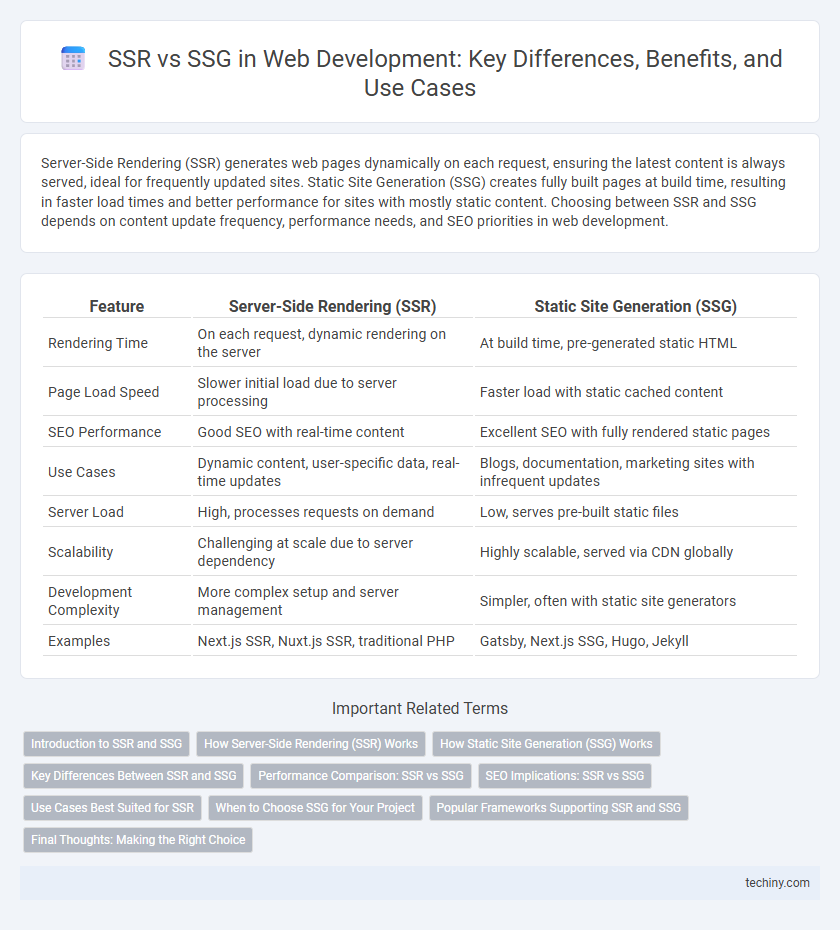Server-Side Rendering (SSR) generates web pages dynamically on each request, ensuring the latest content is always served, ideal for frequently updated sites. Static Site Generation (SSG) creates fully built pages at build time, resulting in faster load times and better performance for sites with mostly static content. Choosing between SSR and SSG depends on content update frequency, performance needs, and SEO priorities in web development.
Table of Comparison
| Feature | Server-Side Rendering (SSR) | Static Site Generation (SSG) |
|---|---|---|
| Rendering Time | On each request, dynamic rendering on the server | At build time, pre-generated static HTML |
| Page Load Speed | Slower initial load due to server processing | Faster load with static cached content |
| SEO Performance | Good SEO with real-time content | Excellent SEO with fully rendered static pages |
| Use Cases | Dynamic content, user-specific data, real-time updates | Blogs, documentation, marketing sites with infrequent updates |
| Server Load | High, processes requests on demand | Low, serves pre-built static files |
| Scalability | Challenging at scale due to server dependency | Highly scalable, served via CDN globally |
| Development Complexity | More complex setup and server management | Simpler, often with static site generators |
| Examples | Next.js SSR, Nuxt.js SSR, traditional PHP | Gatsby, Next.js SSG, Hugo, Jekyll |
Introduction to SSR and SSG
Server-Side Rendering (SSR) generates web pages dynamically on the server for each user request, enhancing SEO and improving initial load times by delivering fully rendered HTML. Static Site Generation (SSG) prebuilds pages at compile time, serving static assets that offer faster performance and lower server load. Both approaches optimize user experience and performance but cater to different use cases based on content update frequency and scalability requirements.
How Server-Side Rendering (SSR) Works
Server-Side Rendering (SSR) processes web page content on the server by generating fully rendered HTML before sending it to the client browser, which improves initial load performance and SEO. During SSR, the server executes JavaScript code and fetches necessary data to build the complete page, reducing the reliance on client-side rendering. This approach enables faster content display, especially for dynamic or personalized web applications, by delivering ready-to-view HTML that enhances user experience and crawlability.
How Static Site Generation (SSG) Works
Static Site Generation (SSG) pre-renders web pages at build time, converting dynamic content into static HTML files served directly from a CDN for rapid load times. By fetching data and compiling templates during the build process, SSG eliminates server-side rendering delays and reduces server load. Popular frameworks like Next.js and Gatsby utilize SSG to optimize SEO and enhance performance by delivering fully-rendered pages instantly.
Key Differences Between SSR and SSG
Server-Side Rendering (SSR) dynamically generates HTML for each user request, ensuring fresh content and better SEO by serving fully rendered pages from the server in real-time. Static Site Generation (SSG) pre-renders HTML at build time, delivering faster load times and enhanced security by serving static files without server-side computations. While SSR suits sites requiring frequent content updates or personalized data, SSG is ideal for mostly static content with predictable changes, balancing performance and scalability.
Performance Comparison: SSR vs SSG
Server-Side Rendering (SSR) generates web pages dynamically on each request, resulting in slower initial load times compared to Static Site Generation (SSG), which pre-builds pages at compile time for faster delivery. SSG improves performance through static caching, reducing server processing and enhancing scalability under high traffic conditions. SSR offers real-time content freshness but may incur latency, whereas SSG optimizes load speed and resource usage by serving static assets directly from Content Delivery Networks (CDNs).
SEO Implications: SSR vs SSG
Server-Side Rendering (SSR) improves SEO by delivering fully rendered HTML to search engine crawlers, enhancing content visibility and indexing speed. Static Site Generation (SSG) also boosts SEO through pre-rendered pages that load quickly and provide consistent metadata, ideal for content that doesn't change frequently. Both SSR and SSG improve crawlability, but SSR is preferable for dynamic content while SSG excels in delivering fast, static content that benefits from strong performance metrics.
Use Cases Best Suited for SSR
Server-Side Rendering (SSR) is best suited for dynamic web applications requiring real-time data updates, such as e-commerce sites with frequently changing inventory or personalized user dashboards. SSR improves SEO rankings and initial load performance by delivering fully rendered HTML from the server, making it ideal for content-heavy platforms like news websites and social media feeds. Applications demanding user-specific content or authentication workflows also benefit from SSR due to its seamless integration with backend data sources and faster time-to-interactive.
When to Choose SSG for Your Project
Static Site Generation (SSG) is ideal for projects with predominantly static content, such as blogs, documentation, and marketing sites, where fast load times and SEO are critical. Choosing SSG enhances performance by pre-rendering pages at build time, reducing server load and improving scalability. SSG is less suitable for frequently updated or highly dynamic content that requires real-time data.
Popular Frameworks Supporting SSR and SSG
React frameworks like Next.js and Remix offer robust support for both SSR (Server-Side Rendering) and SSG (Static Site Generation), enabling developers to optimize performance and SEO. Vue.js, through Nuxt.js, provides flexible rendering modes that allow seamless switching between SSR and SSG for dynamic and static content delivery. SvelteKit, an emerging framework in the Svelte ecosystem, supports hybrid rendering approaches, combining SSR for real-time data fetching and SSG for pre-rendered pages to enhance load speed and user experience.
Final Thoughts: Making the Right Choice
Choosing between Server-Side Rendering (SSR) and Static Site Generation (SSG) depends on the specific needs of your web project, such as performance requirements, content update frequency, and user experience goals. SSR excels in delivering dynamic, personalized content with fast initial page loads, ideal for applications needing real-time data. SSG offers superior scalability and blazing-fast delivery for static content, making it a perfect fit for blogs, marketing sites, or documentation portals.
SSR vs SSG Infographic

 techiny.com
techiny.com